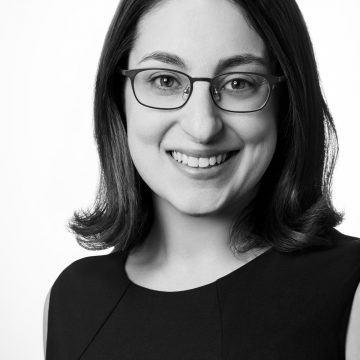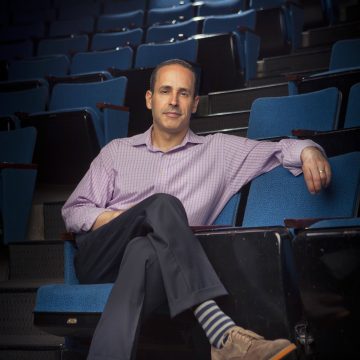Introducing the Digital Yiddish Theatre Project!
Debra Caplan, Joel Berkowitz
Welcome to the blog of the Digital Yiddish Theatre Project, a research consortium dedicated to the application of digital humanities tools and methods to the study of Yiddish theatre and drama.
In future posts, DYTP members, along with guest contributors, will explore the fascinating world of Yiddish theatre. Or perhaps one should say “worlds,” for the subject spans continents, centuries, performance forms, and ideological viewpoints on the part of its playwrights, composers, performers, and audiences. In our scholarly roles, DYTP members delve deep into specific aspects of the Yiddish stage including the close analysis of texts, the chronicles of performers and companies, and assessments of theatrical activity across the globe: from the Russian empire and Soviet Union, into Poland, to London’s East End, New York, Buenos Aires, and beyond.
This blog gives us an opportunity to dip in and out of small moments within those stories: for example, discussing an actor’s contract, or a photo of a production, or a specific play, scene, or song.
The DYTP members are:
Zachary Baker (Stanford University Libraries)
Joel Berkowitz (University of Wisconsin-Milwaukee)
Debra Caplan (Baruch College, CUNY)
Barbara Henry (University of Washington)
Faith Jones (Independent Scholar, Vancouver)
James Loeffler (University of Virginia)
David Mazower (Independent Scholar, London)
Hankus Netsky (New Engand Conservatory of Music)
Eddy Portnoy (Rutgers University / YIVO Institute for Jewish Research)
Aaron Rubinstein (University of Massachusetts Libraries)
Amanda (Miryem-Khaye) Seigel (New York Public Library)
Francesco Spagnolo (Magnes Museum / University of California, Berkeley)
Michael Steinlauf (Gratz College)
Judith Thissen (University of Utrecht)
Jeffrey Veidlinger (University of Michigan)
It seems fitting, given the collaborative and often conversational, nature of the group’s interactions, to devote the rest of this introduction to a brief discussion between the group’s founders, who will say a few words about its history and goals, and about the purpose of this blog specifically.
Joel Berkowitz: Debra, the launch of this blog makes me think back to almost exactly three years ago, at the annual conference of the Association for Jewish Studies, when you and I had a momentous discussion in the lower lobby of the Grand Hyatt Hotel in Washington, D.C. You will undoubtedly remember the circumstances: you had just presented a paper featuring GIS tracking of the Vilna Troupe, the esteemed Yiddish theatre company at the center of your Harvard doctoral dissertation, which you were then in the midst of researching. After your session, a conversation about the particulars of your paper quickly led to an exchange about how else new technologies and methods might be harnessed to enhance the field of Yiddish theatre studies. But we agreed that fancy technology was not enough; what our field needed was a “dream team” of scholars with complementary skills who would be willing to work together, over a long period of time, on projects that the group would decide to pursue.
Debra Caplan: Of course, how could I forget? What started off as a conversation has become a 15-member, international, interdisciplinary scholarly collaboration that has sparked ideas for projects I don’t think any of us ever imagined tackling on our own. To me, the launch of the blog opens up a number of questions about the borders of our field, the audience for our scholarship, and of course, the role of digital tools in shaping our collective research. Thinking back to our conversation three years ago, I remember us discussing the application of specific methodologies to our work — in other words, how digital humanities could impact our research output. But the more I’ve learned about DH, experimented with these tools, and talked about it with the members of our group, the more it’s become clear to me that DH has enormous potential to transform the kinds of research questions and projects that scholars take on in the first place.
There’s been a lot of conversation about applying digital humanities methodologies to a range of fields, but I wonder if we can try to articulate its relationship to our field of Yiddish theatre more precisely. First, what are the ‘big picture’ research questions that DH can help us to answer? Second, and relatedly, why apply these digital humanities methods to Yiddish theatre specifically — what’s the value added that’s specific to this field? Want to take a stab?
JB: Debra you’ve elegantly summed up the crux of the conversations we were having when we initially launched this endeavor, and your ‘big picture’ questions are one indication of how far the discussions have come since then, now that the fifteen of us have been batting ideas back and forth for awhile.
Digital humanities allows us to sift through, manage, and organize quantities and types of information that human beings either couldn’t do on their own, or would take impossibly long to do. One of the fundamental characteristics of scholarship is making connections—noticing relationships between and among disparate bits of information and putting them together in ways that no one has ever done before—or at least not in quite the same way—and as a result adding to humanity’s understanding of the subject at hand. This is true whether one sheds new light on the beauty of the Petrarchan sonnet, notices previously overlooked connections among disparate Galapagos finches, or fills gaps in our knowledge to help us better understand a nation’s history.
Digital humanities can simply do this on a much larger scale: for example, rapidly scanning large amounts of text to find every instance of a particular term being mentioned—say, ‘Warsaw’ or ‘Molly Picon’ or ‘vaudeville.’ It can also create links between different kinds of information. Let’s say we create an interactive timeline of a set of historical events, such as the life and career of a notable actor, that allows users to click on various milestones where one can find information to bring each of those moments to life. That information could include, say, a photograph of the actor taken around that time, a song the actor recorded that year, or a map of the actor’s travels around that time. This helps us visualize information in ways that more traditional forms of scholarship often cannot do. I hasten to add that none of us has anything against traditional scholarship; quite the contrary. But we are interested in complementing such work by harnessing the power afforded us by the many advances being made in the digital age.
There are several reasons why Yiddish theatre and digital humanities can be considered, as we say in Yiddish, a ziveg min ha-shamayim : a match made in heaven. For one thing, it was and is an international phenomenon. Though it originated in central and eastern Europe, Yiddish theatre followed the paths blazed by Eastern European Jews as they emigrated by the millions beginning in the 1880s: to particularly to North America, but also to Latin America, Western Europe, Palestine, South Africa, and Australia. Theatre has often tended to be a peripatetic art; the image of actors constantly traveling from town to town, state to state, or country to country is deeply embedded in the annals of theatre history. But Yiddish theatre is, one could say, a double nomad, traveling toward both the next audience and toward greener pastures, since its fate has so often been intertwined with the lives of Jews living in troubled times and places.
All of this leaves the historian of the Yiddish theatre with a geographically, linguistically, and culturally tangled history. Digital humanities tools are particularly well suited to managing the information needed to make sense of that history: for example, by putting interactive maps in conversation with text, so that the historian can simultaneously show and tell the stories of our ‘vagabond stars.’
I know that much of this can sound like science fiction to readers who don’t feel entirely at home among the technological advances that are changing scholarship so rapidly. But whether you’re writing code at Google or feel proud of yourself just for managing to find this page at all, it’s worth keeping in mind that much of what digital humanities can accomplish is, at least up to a point, simply an electronic version of activities that people have carried out for centuries or even millennia. Publishing is a prime example; one of the main endeavors being planned by the DYTP is the digital publication of texts that are not easily accessible. That being said, digital publishing can enhance the usefulness of such resources—for example, by making them searchable, so that one can zero in on specific terms rather than looking for a needle in a haystack.
Of course, all these technological capabilities ultimately mean nothing without the right people to set them in motion. Would you like to say something about the makeup of the Digital Yiddish Theatre Project, and about how its members work with both technology and with one another?
DC: I love that idea of Yiddish theatre as a double nomad engaging in multiple kinds of perilous, fraught border-crossings all at once. Yiddish theatre, in other words, is a particularly slippery field of inquiry, and the instability of our subject matter tends to mirror the circumstances of its actors and audiences. Geographically, culturally, linguistically, Yiddish theatre is more often than not a moving target.
To me, one of the most exciting aspects of digital humanities is that new methodologies are emerging at a rapid pace, and can deal with large, complex datasets. This is precisely what we are so often faced with in studying Yiddish theatre, and I see tremendous potential for our field in gathering and analyzing the extant data in order to more accurately pinpoint aesthetic trends, intellectual debates, rivalries, partnerships, and networks of influence related to this one short-lived but remarkably influential theatre tradition.
The Digital Yiddish Theatre Project is an experiment in scholarly collaboration across dozens of fields, methodologies, and institutions. We’re a kind of laboratory for new modes of collaborative, public-facing scholarship that are new to all of us, but urgently needed in our field (and dare I say, for the humanities at large). Our fifteen members include theatre researchers, historians, literary scholars, musicologists, film scholars, librarians, archivists, performers, musicians, and independent scholars who are experts in their individual fields. Together, we hope to address the full range of Yiddish theatrical production, from its beginnings to the present day. Our model for working together is constantly evolving, but this blog represents the first fruits of our collaboration: a place for us to share and discuss our findings with each other and also with a wider audience of people who are interested in learning more about the Yiddish stage.

